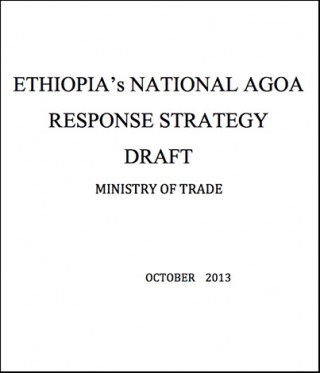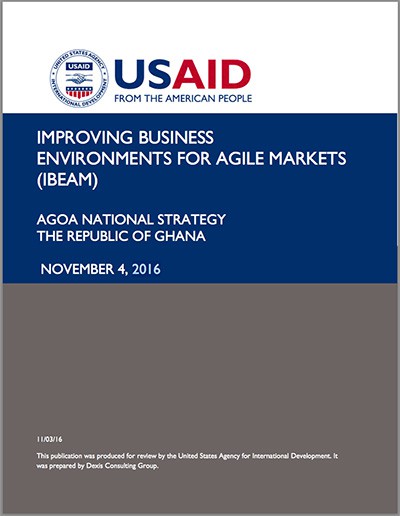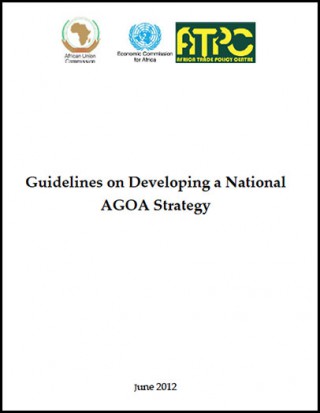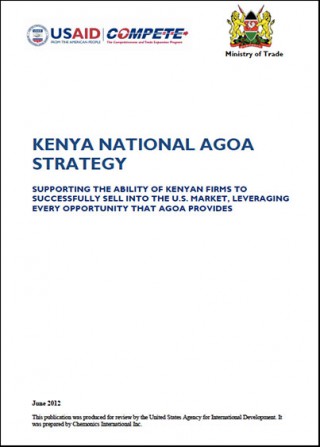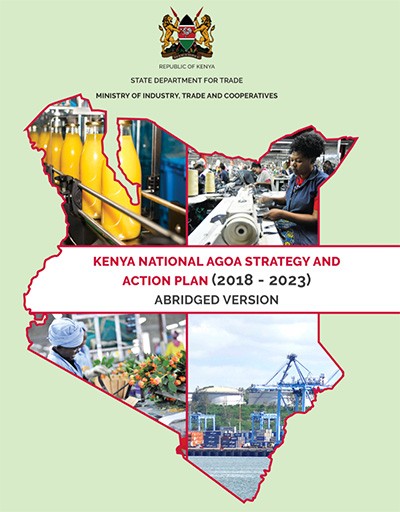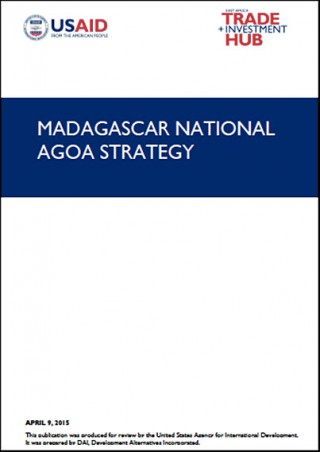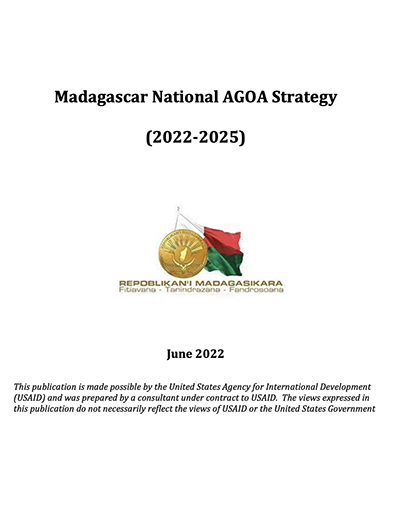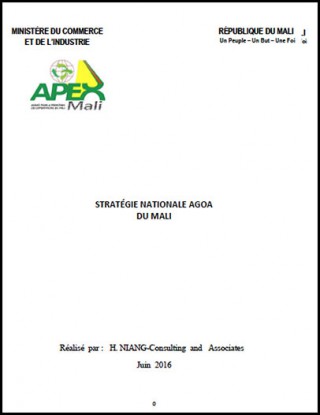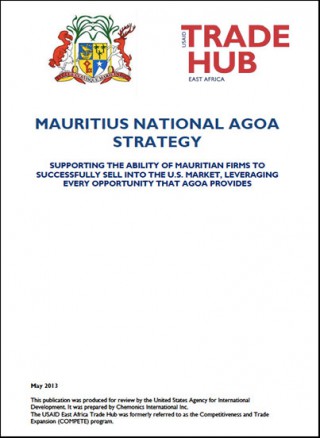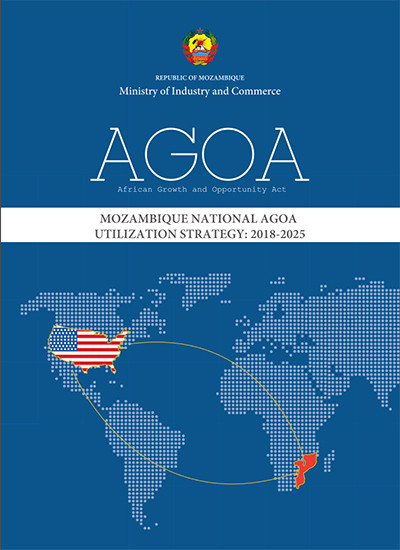National AGOA Strategies
Ethiopia - National AGOA Strategy (DRAFT)
[Note: an updated strategy is currently being prepared]. The Ethiopian Ministry of Trade, in cooperation with the African Trade Policy Center of the UNECA, has undertaken a grand initiative to develop a National AGOA Response Strategy to identify key supply side constraints that impede the performance of the export sector and suggest possible interventions to help overcome these constraints.
Ghana - National AGOA Strategy
The Ghana Ministry of Trade and Industry (MOTI) has taken the opportunity to develop a new strategic approach for utilizing Ghana’s preferential market access to the United States markets, extended by the African Growth and Opportunity Act (AGOA) which was renewed last year through 2025 by an act of the United States Congress. The approach has taken on board the advice offered by Brookings Institute, and the United States General Accountability Office (USGAO) about the importance of developing a strategic approach for utilizing AGOA. This strategy document is the end product of intensive collaboration between Senior MOTI Officials and a team of expert consultants fielded by USAID|Ghana.
Guidelines on developing a national AGOA strategy
This report provides guidelines for developing a National AGOA Response Strategy for African countries that are designated as eligible under the African Growth and Opportunity Act (AGOA). AGOA is a U.S. development effort that was promulgated into law in May 2000 and provides eligible countries in sub‐Saharan Africa with more liberal access to the U.S. market. Initially set to expire in 2008, AGOA was extended to 2015 in 2006, and efforts are currently under way to extend AGOA beyond 2015. ...
Kenya - National AGOA Strategy 2012 (updated version below)
The preferential market access granted to Kenya and other African countries through the Africa Growth and Opportunity Act (AGOA) has played a critical role in spurring Kenya’s exports with the US. This has been most dramatic in the case of the textiles and apparel sector, which grew at 44% a year in the few years after AGOA’s passage. In effect, AGOA has created an apparel industry in Kenya on a scale that the country would unlikely have achieved without preferential access to the US market.
Kenya - National AGOA Strategy 2018-2023
Prepared by the Ministry of Industry, Trade and Cooperatives with support from the United States Agency for International Development’s (USAID) East Africa Trade and Investment Hub. The Kenya National African Growth and Opportunity Act (AGOA) Strategy and Action Plan (2018 – 2023) provides strategies and actions for increasing exports to the United States (U.S.) informed by an analysis of identified priority sectors. The overall approach of the Strategy offers multiple actions in areas ranging from expanding U.S. market share and buyer diversification to trade facilitation, skills development, increasing productivity, trade-support capacity building, and export supply development. The development of the Strategy and Action Plan demonstrates the commitment of the Government in supporting national export activities. The document also confirms the progress we are making as a country in strengthening our relations with the United States especially in areas of export trade and investment.
Lesotho - National AGOA Strategy (updated version below)
The Government of Lesotho (GoL) has decided to prepare a National AGOA Response Strategy with the overarching objective of improving and up-scaling the implementation of AGOA and establishing a diversified manufacturing sector in response to the anticipated extension of the existing AGOA agreement. After 13 years of implementation of AGOA, Lesotho has managed to establish one of the largest textile and garment manufacturing industry in Sub-Saharan Africa (SSA), which has also turned out to be the biggest employer in the country. Until recently, it has consistently been the number one exporter of apparel to the US under AGOA among the SSA countries. This achievement has been no small feat and the GoL is doing everything within its means to protect and sustain the industry, more so because of its labour intensive nature and largely employing women. ...
Lesotho - UPDATED National AGOA Strategy
This document contains a National African Growth and Opportunity Act (AGOA) Utilization (Response) Strategy for Lesotho. The strategy provides a comprehensive plan to increase exports from Lesotho to the United States under the AGOA nonreciprocal unilateral trade preference program and attract more U.S. investment into Lesotho. A detailed Implementation Plan Matrix of this AGOA Utilization Strategy for Lesotho includes strategic objectives, performance indicators, anticipated deliverables and proposed lead and support institution(s) responsible for the implementation of the activity as well as the timeframe for implementation indicated as short term (1-2 years), medium term (over 2-5 years), and long term (over 5 years). The objective for highlighting the strategic activities and specific implementing entities is to provide clarity to avoid duplication of effort and to facilitate effective implementation of the strategy guided by clear monitoring and evaluation (M&E) activities.
Madagascar - National AGOA Strategy (new version below)
The objective of the AGOA strategy is to support the ability of Madagascar’s firms to successfully sell into the U.S. market, leveraging every opportunity that AGOA provides. AGOA has had a clear impact in stimulating Africa-U.S. trade. All exports, including energy-related products, from AGOA-eligible countries have grown over 300 percent, from $21.5 billion in 2000 to $86.1 billion in 2008. It has created more than 300,000 jobs, many of which are in the apparel sector, an industry that provides employment opportunities for women.
Madagascar - National AGOA Strategy 2022-2025
The new Madagascar National AGOA Strategy covers all aspects of analysis and design necessary for the formulation of a post-COVID plan and an update of the previous National AGOA Strategy. As such, the Strategy consists of two primary components. First is an assessment of the COVID-19 impact on Madagascar and AGOA-related sectors. Second is an update of Madagascar’s AGOA strategy, with the goal of developing a road map for the Government of Madagascar to maximize the benefits under AGOA and to implement this strategy to penetrate the U.S. market. The AGOA Strategy identifies the key gaps in private sector comprehension of the AGOA mechanism and U.S. market trends, and formulates plans to correct these deficiencies. The AGOA Strategy consists of a selection of sectors and products with the greatest market potential in the United States. When considering viability for the AGOA market, attention was given to regulatory requirements, standards and related certifications that are needed to enter the U.S. market and highlights the steps necessary for current and potential manufacturers to meet the relevant rules of origin and market-entry requirements. A review of lessons-learned from other countries that have successfully taken advantage of AGOA was also analyzed for benchmarking purposes. The AGOA Strategy looks at best practices and underscores key success factors to be considered and implemented. Finally, and most critically, the AGOA...
Madagascar - National AGOA Strategy 2022-2025 (french version)
La Stratégie nationale AGOA de Madagascar couvre tous les aspects d’analyse et de conception nécessaires à la formulation d’un plan post-COVID et à une mise à jour de la précédente Stratégie nationale AGOA. À ce titre, la Stratégie comporte deux composantes principales. L’analyse identifie les chocs de l’offre et de la demande dus à la pandémie ainsi que les politiques publiques mises en oeuvre à Madagascar et sur les marchés de destination affectant les opérations, la survie et la croissance des secteurs prioritaires de l’AGOA; évalue l’impact de la pandémie sur les perturbations de la chaîne de valeur, l’accès aux intrants, les changements dans les conditions du marché des consommateurs et d’autres facteurs qui affectent les opérations, la survie et la croissance des secteurs prioritaires de l’AGOA; et analyse le potentiel de diversification durable de la production à Madagascar, y compris vers les équipements de protection individuelle (EPI). La stratégie AGOA comprend une sélection de secteurs et de produits présentant le plus grand potentiel de marché aux États-Unis. Lors de l’examen de la viabilité au marché de l’AGOA, une attention particulière a été accordée aux exigences réglementaires, aux normes et aux certifications connexes nécessaires pour pénétrer le marché américain, ainsi qu'aux étapes nécessaires pour que les fabricants actuels et potentiels respectent les règles d’origine et...
Malawi - National AGOA Strategy
This document contains a National Response Strategy for Malawi for the African Growth and Opportunity Act (AGOA) trade preference program. This strategy provides a comprehensive plan for increasing exports from Malawi to the United States under the AGOA nonreciprocal unilateral trade preference program and attracting more U.S. investment into Malawi. Although a beneficiary country under AGOA since its inception in May 2000, Malawi has not significantly utilized the trade preference opportunities offered by the AGOA program. According to USITC Tariff Database, Malawi exports under AGOA (excl. GSP) were US$56.1 million in 2011, mainly consisting of tobacco, and the exports declined to US$46.3 in 2012 before peaking at US$57.4 in 2014. The sharpest decline since 2011 has so far been in 2015 when the AGOA exports went down to about US$41.0 million. However, AGOA exports from Malawi increased by 10% in 2016 to about US$44.9. Total AGOA and GSP exports followed the same trend. Malawi has exported mainly tobacco and limited amounts of macadamia nuts, cane sugar, textiles and apparel (garments) under the AGOA program. In addition, Malawi also exported lentils, basketwork, pigeon peas and household articles under GSP. This National AGOA Response Strategy for Malawi was developed in line with the recommendations of the AGOA Trade Preferences Extension Act of 2015 and is aligned with the objectives of the Malawi National Export Strategy (NES) 2013-2018.
Mali - National AGOA Strategy
La République du Mali est située au coeur de l’Afrique de l’Ouest. Avec une superficie de 1.241.238 km2, c’est un pays continental, qui partage environ 7.000 kilomètres avec 7 pays voisins. Les principaux ports d’approvisionnement du pays sont : Dakar (à 1 400 km environ de Bamako), Abidjan (à 1 200 km), Nouakchott (à 1 600 km), Conakry (à 900 km), de Lomé et de Tema (à 1973 km). L’économie malienne est essentiellement agricole. L’Agriculture contribue pour environ 35 % au Produit intérieur brut et près de 70 % de la population vit en campagne. ...
Mauritius - National AGOA Strategy
The preferential market access granted to Mauritius and other African countries through the Africa Growth and Opportunity Act (AGOA) has played a critical role in spurring Mauritius’ exports with the U.S. The textiles and apparel sector grew annually at a steady rate of 5 percent since AGOA’s adoption and leading non-textile/ apparel exports grew annually at as much as 23 percent between 2001 and 2006 and an overall rate of 12 percent since 2001. In effect, AGOA has contributed to expand the apparel industry of Mauritius on a scale that the country would unlikely have achieved without preferential access to the U.S. market.
Mozambique - National AGOA Strategy
Currently Mozambique has a low level of trade with the U.S. relative to other trading partners. is Strategy is therefore designed to: a.) identify AGOA-eligible sectors and products which Mozambique could export or increase export to the U.S., b.) to provide guidance on increasing the awareness and expertise of AGOA among Mozambique’s relevant public and private stakeholders and c.) to elaborate a set of strategic actions into short-term, medium-term and long term that, if implemented, could help Mozambique to better utilize the AGOA and capitalize on the preferred access to the U.S. market. This strategy includes 21 recommendations on improving awareness of AGOA, competitiveness of specific sectors, and exploiting the benefits granted to goods made in Mozambique for the U.S. market. Each recommendation includes identification of implementing entities as well as a recommended timeframe. As readers will note, there are a range timeframes from immediate to long term for Mozambique to better utilize AGOA and grow exports.


